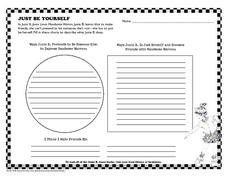Curated OER
Number Chart 1
In this missing number worksheet, learners fill in missing numbers in a 100's chart, 50 numbers total are missing. Worksheet includes link to additional worksheets.
Curated OER
Brush Your Teeth - Recording Sheet
In this teeth brushing chart worksheet, students put a check mark in the squares under the days of the week each time they brush their teeth. They place the marks under the icon of the sun or the moon to indicate if they brushed their...
Curated OER
Connect The Dots
In this connect the dots worksheet, students connect a series of 51 dots to complete a picture of a fairy, then color the picture.
Curated OER
I See Black: Mini-Book
In this mini-book learning exercise on the color black, students read 9 sentences accompanied by pictures that read, "I see a black..." Students then complete the sentence with their own word and picture.
Curated OER
I See Pink: Mini-Book
In this mini-book worksheet on the color pink, learners read 9 sentences accompanied by pictures that read, "I see a black..." Students then complete the sentence with their own word and picture.
Curated OER
Fruit: Citrus or Berries?
In this worksheet on categorizing fruits, students cut out 6 pictures of fruit, then paste them under their correct heading, citrus or berry.
Curated OER
Fruit or Not Fruit
In this instructional activity on fruits, students cut and paste a total of 16 pictures under their correct heading: These things are fruit or These things are not fruit.
Curated OER
Talking About Ability
For this talking about ability worksheet, students learn about conversations pertaining to abilities as they examine 5 example conversations.
Curated OER
Talking About Favorite Things
In this talking about favorite things worksheet, students learn about conversations pertaining to favorite things as they examine an example conversation and consider 3 of their favorite things.
Curated OER
Talking About Likes and Dislikes
In this talking about likes and dislikes worksheet, students learn about conversations pertaining to likes and dislikes as they examine 3 example conversations.
Curated OER
Asking People to do Things
In this asking people to do things activity, students learn to use the word can to convey the idea that they are able to do something as they read 4 examples.
Curated OER
Saying Goodbye
In this language worksheet, students read a number of expressions that can be used when saying goodbye. They see black line pictures that show children using the expressions in speech bubbles. There are no questions associated with this...
Curated OER
Breakfast Venn Diagram
What are your youngsters' favorite breakfast? They examine a Venn diagram with pictures of three breakfast preferences: grits, cereal, or eggs. Then, have them place their initials in a space to indicate favorite choices. This is an...
Curated OER
Eggs Venn Diagram
Do your youngsters already have a favorite way to have their eggs cooked? They examine a triple Venn diagram with pictures of three ways to enjoy breakfast eggs: boiled, fried, or scrambled. Then, they place their initials in the diagram...
Curated OER
Comparisons: More Than, Less Than or Equal To?
In this comparison worksheet, students use a key to help count objects, then complete a graphic organizer, determining sets of objects as being equal to, less than or greater than.
Curated OER
Vocabulary Sketches
In this vocabulary sketch worksheet, students complete a graphic organizer, writing a new word and definition, and then drawing a simple sketch of the word meaning.
Curated OER
Down By the Bay
In this "Down by the Bay" worksheet, students read the poem, respond to 8 short answer question, review 16 sight words, and color and arrange the 14 pictures in chronological order.
Curated OER
Just Be Yourself
In this reading comprehension worksheet, students complete two charts to help them find how Junie B. Jones tried to impress other people and then ways she decided to be herself. Students then write how they think they make friends.
Curated OER
Personal Health Series: Sleep
In this sleep/health activity worksheet, students complete a graphic organizer, drawing or writing words that describe what they do to get ready for a good night's sleep.
Curated OER
Idea Web
In this prewriting activity, students fill in an idea web. No topic is given or suggested. The web can be used with any reading selection and is an organizer with circles for main ideas and lines for related facts.
Curated OER
Do You Like ______________?
In this preferences worksheet, students complete a graphic organizer showing if they like or dislike a given item. They fill in the blank in the question, "Do you like _______?" and fill in the yes or no portion of the graphic organizer.
Curated OER
Types of Home
In this home types learning exercise, students label each of the types of homes pictured by listing the words given in the word bank beneath the pictures.
Curated OER
Writing Stories With Comic Strips
In this writing worksheet, students fill in a comic strip style 3 row graphic organizer to write a short story. Each row shows a starting transition word and students are instructed to include speech bubbles to show what characters are...
Curated OER
Awesome A
In this short a worksheet, 1st graders read a story using the high frequency words come, here, is, an, are, and some as well as words with the short a sound. Students create a student made book of the story and the pictures that accompany.

























